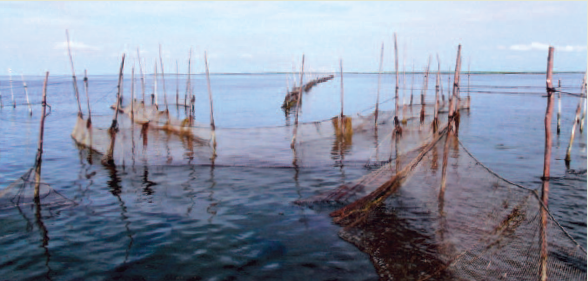Surf and Turf: Chesapeake Bay Watermen Catch Fish with Trees

- By Kathy Westra
On the shores of the Chesapeake Bay, working the water is a traditional way of life. Buddy Oberender, 56, has been fishing the Bay’s waters since he was 14, learning his trade from older men in his bayside community of Toddville, Md. One of the skills he learned is the art of constructing pound nets, huge enclosures built from wood poles and nets that are used to catch fish. It’s an art that has recently relied on Maryland Tree Farmer Rick Abend, whose Abend Hafen Farm in Dorchester County has supplied Oberender with the saplings he needs to make the fish traps.
Oberender uses pound nets to catch alewives and other bait fish used in the crab pots of other Bay watermen. He also catches sea trout and Maryland’s iconic rockfish (striped bass) in his traps. Oberender’s four traps use 600 poles—pine saplings that are each between 22- and 27-feet long and five inches in diameter. He replaces approximately 250 of the poles every year.
His relationship with Tree Farmer Rick Abend began about 10 years ago when he was looking for a new supplier of poles. “My previous supplier had sold his land. Someone recommended Rick, and I began cutting poles on his farm,” Oberender recalls.
Abend sold his first fish-trap poles in 2002. “At first it was word of mouth. My county forester called me and asked if I had anything suitable. He gave a waterman my phone number, and it just kind of took off.” Once the word spread in the close-knit Chesapeake Bay communities, “I didn’t have any problem finding people to buy my trees,” says Abend. “Buddy has been my best repeat customer.”
Between 2002 and 2007, Abend sold 2,025 fish-trap poles, many of them to Oberender. The watermen provide a far more lucrative market for Abend’s loblolly pine saplings than the market provided by pulpwood. “I get two to three dollars per tree— way more than I would get selling it at three dollars a ton for pulpwood,” Abend notes. “It was a win-win situation.”
Oberender agrees that the arrangement has been good for both independent businessmen. “A lot of places I cut are young growth. Usually a Tree Farmer has to pay someone to go in and clear that mess out. This way, watermen like me are taking something the Tree Farmer needs to get rid of, and that we can use. Cutting for fish-trap poles clears the fast-growing young growth away from the dominant trees.”
The business of selling fish-trap poles has been so good that Abend Hafen Farm no longer has enough saplings of the right size to meet the fishing community’s needs, and for the time being Abend has turned over the market to other Tree Farmers in the Chesapeake Bay region. With an eye to the future, though, Abend planted a new 14 acre stand of loblolly pine in 2011. Even though “it will probably be 15 years before those trees are large enough to use for fish-trap poles, as long as there are watermen willing to buy them, we’ll grow them.”
Despite Abend’s optimism about his unique market niche, the future of fishing with pound nets is in question. Oberender is one of only a handful of watermen on the Bay who still use and know how to build the traditional traps. Fish-trap construction is a “dying art,” Oberender says, as younger watermen turn to other kinds of fishing. “Nobody young can afford to get into fishing with traps,” he laments.










Comments: